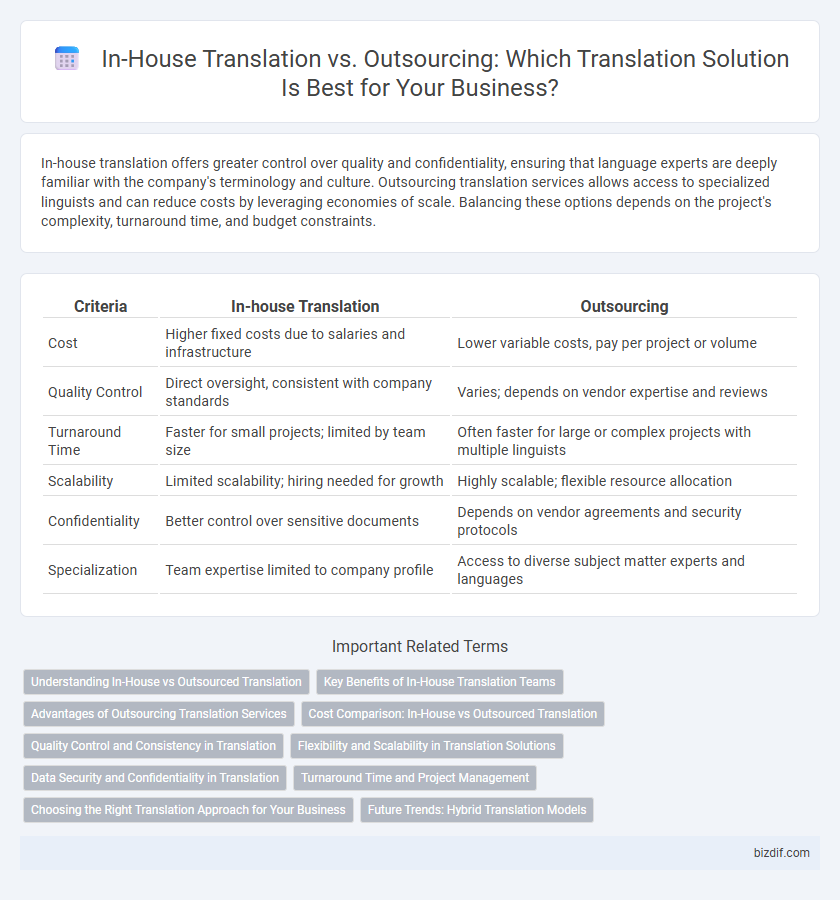In-house translation offers greater control over quality and confidentiality, ensuring that language experts are deeply familiar with the company's terminology and culture. Outsourcing translation services allows access to specialized linguists and can reduce costs by leveraging economies of scale. Balancing these options depends on the project's complexity, turnaround time, and budget constraints.
Table of Comparison
| Criteria | In-house Translation | Outsourcing |
|---|---|---|
| Cost | Higher fixed costs due to salaries and infrastructure | Lower variable costs, pay per project or volume |
| Quality Control | Direct oversight, consistent with company standards | Varies; depends on vendor expertise and reviews |
| Turnaround Time | Faster for small projects; limited by team size | Often faster for large or complex projects with multiple linguists |
| Scalability | Limited scalability; hiring needed for growth | Highly scalable; flexible resource allocation |
| Confidentiality | Better control over sensitive documents | Depends on vendor agreements and security protocols |
| Specialization | Team expertise limited to company profile | Access to diverse subject matter experts and languages |
Understanding In-House vs Outsourced Translation
In-house translation teams offer direct control over project quality, consistency, and confidentiality, leveraging deep company knowledge for accurate and culturally relevant content. Outsourced translation provides scalability, access to diverse linguistic expertise, and cost efficiency, especially beneficial for large or fluctuating workloads. Choosing between in-house and outsourced translation depends on project complexity, volume, budget constraints, and the need for specialized language skills.
Key Benefits of In-House Translation Teams
In-house translation teams provide greater control over quality and consistency by enabling direct collaboration with subject matter experts and project managers. They ensure faster turnaround times due to streamlined communication and dedicated resources focused solely on the organization's specific language needs. Maintaining confidentiality and data security is more manageable with in-house teams, reducing risks related to sensitive or proprietary information during the translation process.
Advantages of Outsourcing Translation Services
Outsourcing translation services offers access to a broad network of specialized linguists skilled in diverse industries, ensuring high-quality, culturally accurate content. It reduces operational costs by eliminating the need for in-house staff and resources, allowing companies to scale projects efficiently. Leveraging advanced translation technology and project management systems through external providers enhances turnaround times and consistency across global markets.
Cost Comparison: In-House vs Outsourced Translation
In-house translation typically incurs higher fixed costs due to salaries, training, and infrastructure, making it less cost-effective for companies with fluctuating translation needs. Outsourced translation offers variable pricing models and access to specialized linguists, which can reduce overall expenses and improve scalability for businesses. Cost comparisons reveal that outsourcing often provides better budget control and flexibility without compromising quality.
Quality Control and Consistency in Translation
In-house translation teams offer enhanced quality control through direct oversight and immediate feedback mechanisms, ensuring linguistic consistency across projects. Outsourcing translation can introduce variability in terminology and style, making rigorous vendor management and standardized guidelines essential to maintain uniform quality. Leveraging centralized translation memory and glossaries supports consistency regardless of the approach.
Flexibility and Scalability in Translation Solutions
In-house translation teams offer direct control and quick adaptability to project changes, making them ideal for companies with consistent volume and specific industry expertise. Outsourcing translation services provides greater scalability, allowing businesses to rapidly adjust to fluctuating translation demands without the overhead of maintaining permanent staff. Combining both approaches can optimize flexibility and cost-efficiency in managing diverse and evolving multilingual content.
Data Security and Confidentiality in Translation
In-house translation teams offer enhanced data security and confidentiality by maintaining direct control over sensitive documents and limiting exposure to external parties. Outsourcing translation services can introduce risks related to unauthorized data access, despite confidentiality agreements and secure platforms. Companies handling proprietary or classified information often prefer in-house solutions to mitigate potential breaches and ensure compliance with data protection regulations.
Turnaround Time and Project Management
In-house translation teams typically offer faster turnaround times due to direct communication and immediate access to project resources, streamlining workflow processes. Outsourcing translation projects can face delays caused by external coordination, varying time zones, and dependency on third-party schedules, which may impact delivery speed. Efficient project management in-house allows for centralized control and quick adjustments, whereas outsourcing requires robust coordination tools to manage timelines and quality across multiple vendors.
Choosing the Right Translation Approach for Your Business
Selecting the right translation approach depends on factors like budget, project complexity, and language expertise required. In-house translation offers better control and consistency for ongoing projects, while outsourcing provides access to specialized skills and scalability for diverse languages. Evaluating your business needs alongside quality standards ensures effective communication across global markets.
Future Trends: Hybrid Translation Models
Hybrid translation models combine in-house and outsourcing strategies to enhance flexibility and scalability in global content management. These models leverage advanced AI-driven translation tools alongside professional human translators to balance efficiency, quality, and cost-effectiveness. Future trends indicate widespread adoption of hybrid approaches to meet diverse localization demands and optimize turnaround times.
In-house Translation vs Outsourcing Infographic

 bizdif.com
bizdif.com